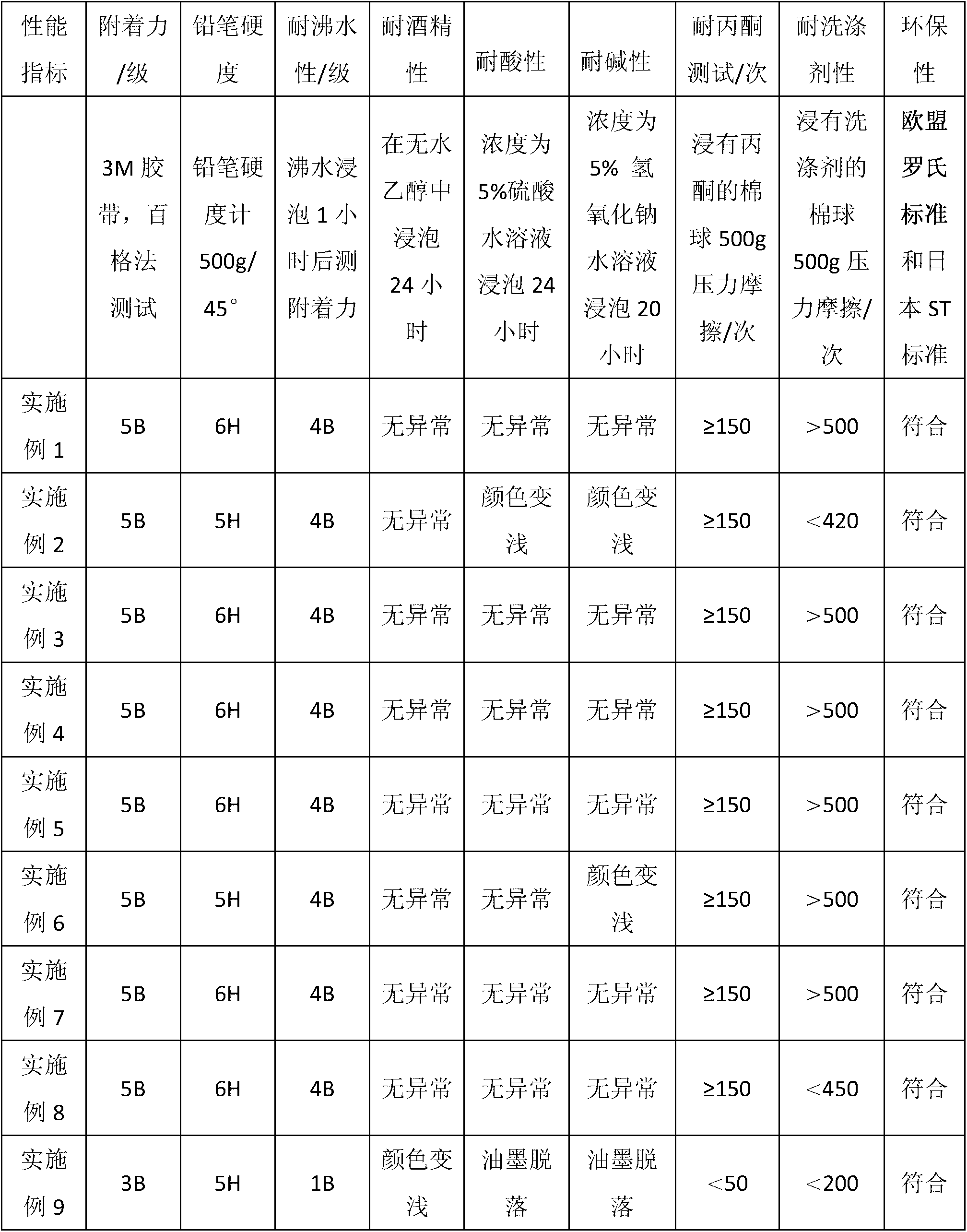Benzoxazine-modified epoxy glass printing ink and preparation method and application thereof
A technology of epoxy resin glass and benzoxazine, which is applied in the field of benzoxazine modified epoxy resin glass ink and its preparation field, can solve the problem of weak adhesion between low temperature curing ink and substrate, acid and alkali resistance, water resistance, etc. , Unsatisfactory alcohol property, unsatisfactory ink peeling resistance, etc., to achieve the effect of improving the final performance, significantly improving the performance, and increasing the crosslinking density
- Summary
- Abstract
- Description
- Claims
- Application Information
AI Technical Summary
Problems solved by technology
Method used
Image
Examples
Embodiment 1
[0026] a) In a clean environment with a temperature of 20-25°C and a relative humidity of about 60%, weigh 60 parts of epoxy resin E-20 and 10 parts of epoxy resin E-44 into the batching bucket, add 18 parts of B Diol monobutyl ether and 12 parts of dimethyl nylon acid (DBE), after being stirred evenly, liquid epoxy resin is obtained.
[0027] b) Weigh 70 parts of liquid epoxy resin and 12 parts of phenol / diphenylmethanediamine type benzoxazine, heat to 75° C. and stir for 15 minutes, and obtain ink binder after uniform dissolution.
[0028] c) Weigh 82 parts of the ink binder obtained in step b), 10 parts of carbon black, 0.7 parts of dispersant CH-5, 2 parts of superfine aluminum silicate, 0.8 parts of defoamer BYK-020, and 2.5 parts of leveling agent EFKA-3034 1 part, 2 parts of thickener fumed silica, mixed and stirred evenly, and ground by a three-roll machine until the fineness is below 16 μm to obtain benzoxazine modified epoxy resin glass ink.
[0029] d) After the be...
Embodiment 2
[0031] a) In a clean environment with a temperature of 20-25°C and a relative humidity of about 60%, weigh 60 parts of epoxy resin E-20 and 10 parts of epoxy resin E-44 into the batching bucket, add 30 parts of B Glycol monobutyl ether, after stirring evenly, liquid epoxy resin is obtained.
[0032] b) Weigh 70 parts of liquid epoxy resin and 10 parts of bisphenol A / aniline benzoxazine, heat to 75° C. and stir for 15 minutes, and obtain ink binder after uniform dissolution.
[0033] c) Weigh 80 parts of ink binder obtained in step b), 12 parts of carbon black, 0.7 parts of dispersant CH-5, 2 parts of superfine aluminum silicate, 0.8 parts of defoamer BYK-066N, and 3 parts of leveling agent EFKA-3033 1.5 parts, thickener fumed silica, 1.5 parts, mixed and stirred evenly, and ground by three-roll machine until the fineness is below 16 μm to obtain benzoxazine modified epoxy resin glass ink.
[0034] d) After the ink has been placed for two days, take 20 parts of finished ink, add...
Embodiment 3
[0036] a) In a clean environment with a temperature of 20-25°C and a relative humidity of about 60%, weigh 60 parts of epoxy resin E-20 and 10 parts of epoxy resin E-44 into the batching bucket, add 18 parts of B Diol monobutyl ether and 12 parts of dimethyl nylon acid (DBE), after being stirred evenly, liquid epoxy resin is obtained.
[0037] b) Weigh 65 parts of liquid epoxy resin and 15 parts of bisphenol A / diphenylmethanediamine benzoxazine, heat to 75° C. and stir for 15 minutes, and obtain an ink binder after uniform dissolution.
[0038] c) Weigh 80 parts of the ink binder obtained in step b), 12 parts of carbon black, 1 part of dispersant CH-6, 2 parts of superfine aluminum silicate, 0.6 parts of defoamer TSA750S, and 2.4 parts of leveling agent EFKA-3500 , 2 parts of thickener fumed silica, mixed and stirred evenly, and then ground by a three-roll machine until the fineness is below 16 μm to obtain benzoxazine modified epoxy resin glass ink.
[0039] d) After the ink...
PUM
 Login to View More
Login to View More Abstract
Description
Claims
Application Information
 Login to View More
Login to View More - R&D
- Intellectual Property
- Life Sciences
- Materials
- Tech Scout
- Unparalleled Data Quality
- Higher Quality Content
- 60% Fewer Hallucinations
Browse by: Latest US Patents, China's latest patents, Technical Efficacy Thesaurus, Application Domain, Technology Topic, Popular Technical Reports.
© 2025 PatSnap. All rights reserved.Legal|Privacy policy|Modern Slavery Act Transparency Statement|Sitemap|About US| Contact US: help@patsnap.com

